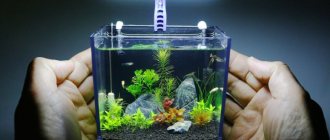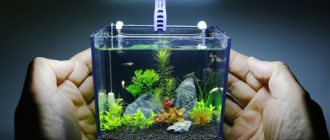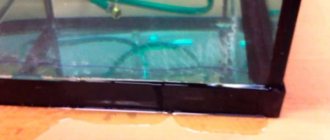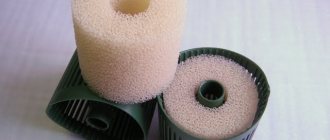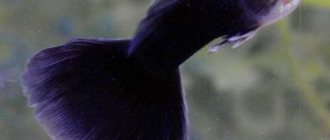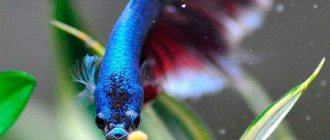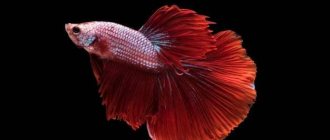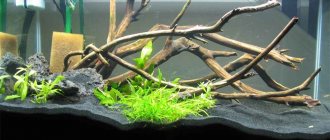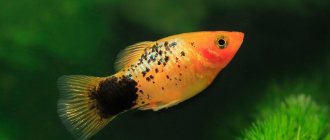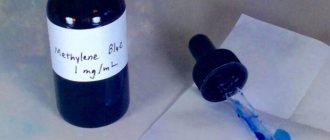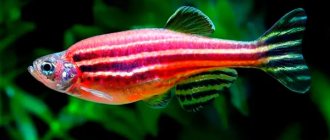Yes, of course, bettas are hardy fish; in their natural habitat they live in muddy, silty, oxygen-free rice fields. But this does not mean that they can be kept in a small glass of water. Firstly, because the conditions of keeping any animal should be as close as possible to natural living conditions. Monkeys must jump in trees, birds must fly, and fish must swim! When a cockerel fish just hangs in a glass with its fins down, it’s actually a sad sight. Secondly, in a glass, vase and other small vessels there is no biobalance . In a rice field, for example, various biochemical processes occur that clean the water from various poisons (ammonia, nitrites and nitrates), but in a glass of water these processes are absent, the poisons accumulate, the fish’s immunity weakens and it dies. Biological balance in artificial conditions can only be achieved in aquariums with filtration, aeration, stable temperature conditions and other attributes of a “normal aquarium”.
Cockerel fish photo
So, the minimum volume of an aquarium for bettas should be 5-10 liters. You can put a mini-filter in such an aquarium, such an aquarium can be beautifully arranged in a natural way, you can plant aquarium plants, adjust the biobalance, and caring for such a reservoir is much easier than washing the “pot” every week, while causing enormous stress to the fish.
Cockerel fish photo
The modern aquarium market provides a wide selection of nano-aquariums for bettas. There are aquarium cubes, there are balls. For example, the Tetra cascade globe is interesting because it is equipped with a waterfall filter, which filters and aerates the aquarium.
Such an aquarium will be an excellent home for a betta; it can be properly and beautifully furnished. The only thing you need to buy is an inexpensive mini heating pad to maintain a stable temperature, for example, this one . And this is not necessary if in winter the room where the aquarium is located is constantly warm.
Very often, cockerels are taken into children's aquariums. If this is your situation, we recommend that you look at this material .
Personally, we are only for children to be involved in the aquarium hobby from a very early age. Such aquarium installations are a form of play for children. It is important here that parents themselves study the basics of aquarium keeping and set up the aquarium correctly from the very beginning. This will be the key to the child’s success and joy.
Varieties
The betta fish was first selected in 1910, giving it a colored color. Today there are more than 10 species of betta. They differ from each other in color:
- plain (red, yellow, white, black, blue, turquoise, purple);
- two-color (the color of the fins differs from the body color);
- multicolor (marble color, butterfly, dragon).
And also by the type of fins.
| Betta Over Halfmoon |
Betta crowntail |
| Short-tailed cockerel (Betta Plakat) |
| Veiltail cockerel (Betta Veiltail) |
| Delta-tailed Betta (Betta Super Delta) |
Betta Double Tail |
| Elephant-eared cockerel (Dumbo) (Betta Dumbo) |
General information
Betta fish belong to the suborder Labyrinth fish. Their peculiarity is the presence of a special respiratory organ called a labyrinth. This organ is represented by plates densely penetrated with blood vessels and is located in the accessory epibranchial plane. Thanks to it, bettas can use atmospheric air to breathe. This type of breathing is vital for aquarium bettas, so keeping them in a closed vessel, even well saturated with oxygen, leads to the death of the fish. The labyrinth appeared among cockerels as an adaptation to living in reservoirs poor in oxygen.
The betta is called a fighting fish because of its strong intraspecific aggression and territoriality.
Betta fish are extremely unfriendly with each other, and very often a collision between two males leads to the death of one of them. This feature has been used since ancient times by the residents of Thailand to conduct tournament fights for money. In some provinces this tradition is still alive.
Interesting training methods are used to prepare cockerels for tournaments. To increase stamina, the cockerel is placed in a tall bottle and forced to swim up and down for a long time. A mirror is moved along the glass, in which the betta can see its reflection. Creating a whirlpool in a round vessel also allows the cockerel to develop its strength. The fighting technique is perfected when the cockerel is placed with younger, weaker males.
Despite the ferocity of the clashes, “cockfights” are not without nobility. A male cockerel will never attack an opponent while he rises to the surface to swallow another portion of air. Also, if three males intersect in one place, the third does not interfere in the fight of the other two, but prefers to fight with the winner.
Compatibility of cockerels with other fish
A cockerel can live in an aquarium with other fish, but it is worth considering similar conditions of detention, nutrition and its aggressiveness. Small fish and representatives with large fins do not get along with the betta, and even eats snails.
| Get along well | They get along, but there are rare fights | Incompatible |
|
|
|
Description
The Siamese betta belongs to the macropod family and is a labyrinth fish. This means that its structure contains a special organ (labyrinthine), which allows it to breathe not only with gills under water, but also with atmospheric air. This individual must always have free access to the surface so as not to die from suffocation.
Female fighting fish reach a length of 4 cm, males - 5 cm.
The first wild representatives of the species had a grayish or greenish coloration. Depending on the emotional state of the individual, darker stripes appear on its body, which can be located both along and across.
Now the types of Siamese cockerel are diverse and amaze with their color variations - scarlet, azure, topaz, turquoise, pink, snow. Macorpods are one of the most beautiful inhabitants of the aquarium. At the same time, the cycloid scales have such a structure that it allows the light falling on it to shimmer, changing shades.
This feature is more characteristic of males during spawning or skirmishes with other individuals. Females are paler, smaller, usually with short fins.
How to distinguish a male from a female betta
Adult betta fish have fairly distinct sex differences. The male is larger, has a brighter color, and has longer fins. Until 2 months of age, it is much more difficult to distinguish a female from a male, but there are still several differences:
- the female has a wide and round ventral fin;
- a more rounded abdomen, on which the ovipositor (white dot) is visible;
- she is calmer and less aggressive.
Feeding
Bettas, despite their small size, are very voracious, but unpretentious in their choice of food and can eat almost anything. Therefore, you can use food in any form - dry, live or frozen. But if an aquarist wants beautiful pets to please their household for as long as possible, it is advisable to correctly plan their diet.
Most of the food should be given to live food. This could be bloodworms, tubifex, daphnia, crushed earthworms, snails.
Bettas should be given food at least twice a day. But you can’t leave excess of it in the water. Food should be poured in such a quantity that it can be eaten within 20 minutes. After this time, the residue must be removed.
To prevent obesity and overfeeding, it is advisable to regularly, preferably weekly, carry out a fasting day, during which you do not put food into the water at all.
Reproduction
Males mature quickly and are considered sexually mature at the age of 4 months, and begin to reproduce at 6-8 months. A pair of the same breed, and preferably the same color, is suitable for breeding.
Preparation for spawning takes several stages:
- For spawning it is better to equip a separate aquarium. A 4-5 liter tank with a water level of no more than 10-12 cm is suitable. Soil is not placed at the bottom, but plants are needed. The female creates shelter in them, and the male often uses them to build a nest.
- It is advisable to separate the female and male from each other for a week, during which time the female’s abdomen will noticeably become rounder.
- Then the fish are allowed into the spawning aquarium and their temperature is constantly raised to 28-30°C, this stimulates spawning.
- The male will begin to build a nest of foam on the surface of the water, which takes him from 1 to 3 days. If the pair is selected successfully, spawning will begin within a couple of hours.
- During spawning, the male courts the female, picks up the eggs and carries them to the nest.
After the end of spawning, the male drives away the female (she needs to be removed), and he himself takes care of the eggs in the nest: adding bubbles, removing unfertilized eggs. When the fry hatch and begin to swim, the male also needs to be removed, otherwise he may crush the fry.
During one spawning, 200 eggs are released, about a third of them survive.
Features of behavior
The strikingly beautiful appearance of the aquarium betta is in sharp dissonance with its fighting character. It is difficult to imagine that such a gentle creature, reminiscent of a water angel, is capable of fighting with its brothers for hours.
Males come into conflict with each other instantly and for any reason - because of a female, food, river. For this reason, you should not stock two male bettas in the aquarium.
Females are much calmer and usually treat each other friendly. But it is not always possible to predict their tempers.
The best combination for one pond is one male and a pair of females.
The male betta does not treat other inhabitants of the aquarium in the best way. Therefore, it is necessary to select neighbors for him extremely carefully.
The warlike temperament demands battles, even if there is no opponent nearby. Some of the more aggressive specimens can spend hours fighting with their reflection in the glass of the aquarium. But it is necessary to populate the pond with other fish; some of the species make the betta’s character much more peaceful and have a beneficial effect on the situation in the home pond. It's all about the right neighborhood.
Caring for fry
The fry grow quickly and do not require much effort, you just need to follow some recommendations:
- in the first days, feed brine shrimp or ciliates.
- after 7 days you can already give specialized granulated food for fry or finely chopped tubifex;
- replace ¾ of the water in the aquarium daily;
- in 2-3 weeks it is advisable to sort large individuals from smaller ones;
- At the age of 4 weeks, the fry are transferred to a large aquarium.
About mini aquariums
Small aquariums with a volume of 5 - 20 liters (in the case of freshwater) are usually called mini or nano. This is a fashionable trend in aquarium keeping, because not everyone can afford to place a weighty aqua of 100 or more liters in their apartment. But I still want to admire the fish. There are, however, pitfalls in maintaining a mini aquarium.
Mini aquariums are a broad concept. If on the far left you can keep a cockerel or other fish alone, then those on the right are not suitable for life!
A small aquarium needs to be cleaned much more often than a large one. For clarity, please see the table.
| Aquarium volume (liters) | 4 -5 | 6 — 10 | More than 20 |
| Interval between cleaning (in days) | 3 | 5 | 7 |
When cleaning, replace no more than 1/4 of the water. Because a complete fluid change is a huge stress for pets: fish, snails, even plants! Such cleaning is necessary only in extreme cases, for example, when a reservoir is infected.
Potential Micro Aquarium Vests
A mini aquarium is often decorated with live plants. Which, in turn, can serve well by improving water quality. But they can also ruin it. If you notice darkened leaves or stems, fallen parts of plants or other damage, they should be immediately removed from the water by carefully trimming them with scissors. Otherwise, rotting plants will quickly spoil the water in a small container.
Modern artificial plants perfectly decorate the aquatic interior. You can choose not only plastic greens, but even silk ones!
When placing plants and decorations in the aquarium, do not forget about a sense of proportion and space for the pet to move freely.
Diseases
With good care at home, a cockerel can live for about 3 years. But if the aquarium is poorly maintained, overfed or fed with live food, there is a risk that the betta will get sick.
Diseases can lead to the death of a pet, so you should pay attention to the appetite and behavior of the fish, because these are the first signs of any ailment.
Fin rot:
- Symptoms. The edges of the fins first become dull, then erosion appears, which grows intensively over the entire surface of the fin. Then the process of rotting occurs, and the fin disintegrates.
- Causes. The causative agent of the disease is the bacterium Pseudomonas. It occurs due to poor quality or untimely cleaning of the aquarium, when feeding contaminated food or introducing infected fish and plants.
- Treatment is carried out with salt baths and streptocide. It is also important to disinfect the aquarium, change some of the water, and rinse the plants and soil.
Costiosis:
- Symptoms. A gray spot with copious mucus secretion and clouding of the skin are formed.
- Causes. The parasite is caused by a flagellate, which can be introduced into an aquarium with live food or infected fish.
- Treatment is carried out with furazalidone and malachite green. In this case, it is necessary to change the water by 20-30% every day. As a rule, fish recover within a week.
Dropsy:
- Symptoms are a swollen belly, raised scales, redness of the fins and abdomen, loss of appetite, apathy.
- Causes. Incorrect feeding of fish, supplementary feeding, infections.
- For treatment, use Bicillin 5, white streptocide, and a weak solution of potassium permanganate.
Ichthyophthiriasis:
- Symptoms. Small white dots (similar to semolina grains) appear on the fish's head, which spread throughout the body. Lethargy, loss of appetite, swims in jerks.
- Causes. Introduced into the aquarium with new fish or plants. The culprit may also be live food contaminated with ichthyophthyriasis.
- Treatment is carried out with salt baths, malachite green, bicillin 5, antipar preparations.
By following all the recommendations for caring for a cockerel, the fish will delight you with its beauty, absence of diseases and large offspring.
History of fighting fish and natural habitat
The Siamese betta is native to the waters of Southeast Asia, Indonesia and China. The first written data about betta dates back to the beginning of the 19th century. Fishermen of Siam (modern Thailand) noticed a small fish that was very aggressive towards its relatives.
The first specimens caught were not particularly bright and had a small, inconspicuous body with short fins. Short breeding work made it possible to develop the Pla Kat species, which translates as “biting fish.”
In the mid-19th century, several specimens of the new type were given by the royal family of Siam to Doctor of Biological Sciences Theodor Cantor for scientific description. The scientist gave it the name Macropodus pugnax, which was later changed to Betta splendens, which can be translated from Latin as “beautiful warrior.”
In the late 19th and early 20th centuries, the Siamese betta appeared in France, Germany and the United States of America. Here, a new color species of fish is soon hatched, called Betta cambodia.
The Siamese cockerel most likely came to Russia thanks to the famous aquarist Desnitsky. Although, according to another version, another professional V. Melnikov began breeding labyrinth fish for the first time in Rus'.
In China, children collected fish from swampy ponds. In an hour it was possible to catch up to 50 pugnacious cockerels. Then the audience staged water fights between them.
Pla Kat was developed for licensed fights. The winner was considered the individual who, even after several hours of fighting, showed readiness for the next fight. These were no longer just cruel games of children, the stakes in these games were very high. Sometimes entire families ended up on the street as a result of the loss of the head of the clan.
In Siam, this business has long been supervised by the royal family. And until now, fighting fish is grown here for licensed games.
Photo gallery:
Lifespan
How long does a rooster fish live in an aquarium environment? This question cannot be answered unambiguously, since the genetics of all fish are different. Many fry do not develop after they begin to swim, move chaotically and die, while others grow successfully. Bettas live in aquariums from one to five years. If the temperature and diet are not observed, the cockerel dies quickly enough.
5 years is a difficult life expectancy to achieve. However, you need to strive for it. Experts recommend monitoring water and nutrition, not overfeeding pets, not housing them with other cockerels, but training them using a mirror placed in the aquarium. Spawning can also extend the life of a pet, so it is sometimes recommended to bring males and females together to produce offspring.
Price
Since there are many types of Siamese fighters, their prices differ. Simple crown-tailed and veiled-tailed specimens can be purchased for 190 rubles, although you can also find breeders who are willing to give the fish away for free. A female will cost even less - 130 rubles. Superdelta and elephant ear are more expensive - about 400-500 rubles. The cost of a cockerel with a crescent tail and a Cambodian dragon is 900-1000 rubles. Butterfly cockerel – 2000 rubles. Prices depend on the beauty and age of the fish. The more beautiful and rare the fish, the higher its price.
The most expensive specimen of a Siamese fighting fish was sold for $1,700 at an auction held on November 15, 2016.
She stood out because her color repeated the colors of the Thai flag - white, blue and red horizontal stripes. Other high-priced cases included a fancy copper white and red Betta that sold for $747, a white platinum dragon that sold for $680 and a Crescent Betta King Gold Dragon that sold for $570. The last two fish are distinguished by their uniform, delicate color and huge flowing fins.
